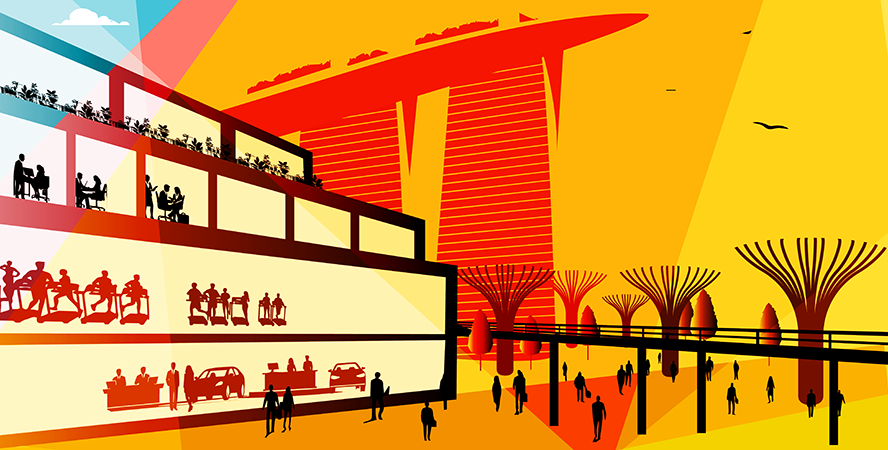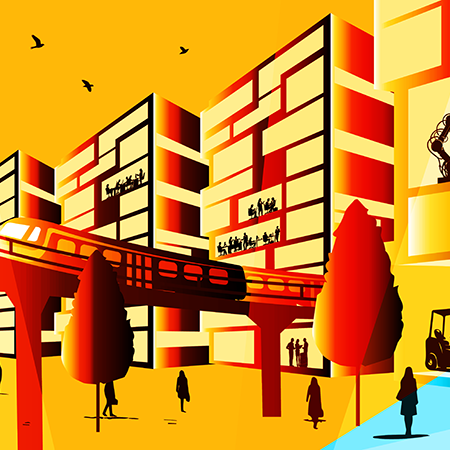What has been the impact of hybrid working on the market?
Unlike most developed countries, working from home (WFH) is still a rarity in Singapore, as it is in most of Asia. Hybrid working arrangements, however, where employees need to be in the office for – normally – two days a week are now commonplace. This 3:2 arrangement is often rostered among team employees to determine who will be on site on which day of the week.
Vacancy rates for Grade A central business district (CBD) office space in Singapore are still rather low, due to undersupply. Just 655,000 sq ft (68,851 sq m) of net lettable area was added to existing stock in 2023 – a miniscule amount, given that this brought the total net floor area of Grade A CBD offices to 34.2 million sq ft. Vacancy rates started 2023 at 6.5% in Q1, peaked at 7.1% in Q3 – due to more shadow space coming back on to the market – then ended the year at 6.7%. In the absence of significant new office completions, much of these spaces were backfilled by companies moving over from non-Grade A buildings.
What are the current office take-up trends?
The net take-up of Grade A CBD office space in 2023 was about 370,000 sq ft (34,374 sq m) net lettable area. The pre-Covid-19 five-year average, from 2015 to 2019, was 1 million sq ft (92,903 sq m), while the 10-year average was 1.2 million sq ft (111,483 sq m).
The slower take-up is symptomatic of companies facing challenging business conditions. The repercussions from Covid-19 lockdowns are still being felt and supply chains in the region are being rewired. On top of that, hybrid work arrangements have curbed companies’ desire to expand their office footprint.
Top-of-class AAA-grade office buildings have the highest occupancy rate, with A and AA grades slightly lower – a flight-to-quality pattern seen in all the major global gateway cities.
How is the stock upgrading to green standards progressing?
In Singapore there are broadly three Business and Construction Authority (BCA) Green Mark ratings: Gold, Gold Plus and Platinum. All generic Grade A offices are at least Gold-rated, while most AAA and some AA offices have the Platinum Mark. Some offices in this category even have the Platinum Super Low Energy rating. Green Mark ratings are not only for the building; individual office units can also obtain a rating. Savills Singapore’s internal office premises, for example, was rated Platinum in 2023.
How are the demand and supply dynamics likely to evolve over the next decade?
Headcount limitations for Grade A office space in Singapore are governed by the occupant loading consideration in the Fire Safety Code, which assigns an interior office space of 10 sq m (108 sq ft) per worker (excluding meeting rooms, pantry and reception). The growth of hybrid working means that many tenants have rightsized to a smaller office, so workers will have to schedule their time in their official workplace.
For many non-real estate companies, rightsizing was left on the backburner in 2021 and 2022 as they focused on their main business lines reawakening. Tenants that had signed leases of five years or more in 2018 or 2019 for large floor areas in Grade A CBD buildings have also not had a chance to completely change tack, opting to find replacement tenants to take up any unwanted space when their business stalled.
It is only in 2025 that we will see more major leases coming up for renewal. Given the lead time to find and negotiate alternative locations, many tenants will start to explore the marketplace this year. This will include the option of rightsizing – either within their premises or in a new building. Few tenants will have the requisite budget for relocating and a subsequent fit out, so we expect rightsizing within current premises to be the norm. Hybrid working patterns, therefore, will help companies pare overheads while placating employees, especially the Gen Zs, with a semi-WFH scheme.
Rightsizing to rent less office space would normally mean paying higher rents per square foot, but tenants are expected to take a harder line during lease negotiations, reining in that increase. Rents for Grade AAA offices in the CBD, because most are close to full occupancy, should be steady, whereas Grade AA and Grade A properties may well reduce rents to retain their tenants. Overall, we expect Grade A CBD rents to slide 2-3% in 2024 – versus a 1.1% rise in 2023.
What are the challenges and opportunities in the repurposing process?
Although there are schemes to incentivise landlords to repurpose their assets in the CBD, such as the CBD Incentive Scheme, few have done so. Landlords are concerned about the high Land Betterment Charges they need to pay for repurposing to, say, a residential property. On top of this, the parts of the CBD that need rejuvenating have plot ratios that limit their height, and thus the view. Spatial separation from buildings across the street is minimal and older buildings also have much lower ceilings than modern Grade A office buildings.
Nevertheless, as tenants from countries with stricter ESG standards find themselves unable to rent buildings that are non-Green rated, landlords will be forced to repurpose, redevelop, or sell up.
A version of this article was first published in The Business Times online on 1 May 2024.



